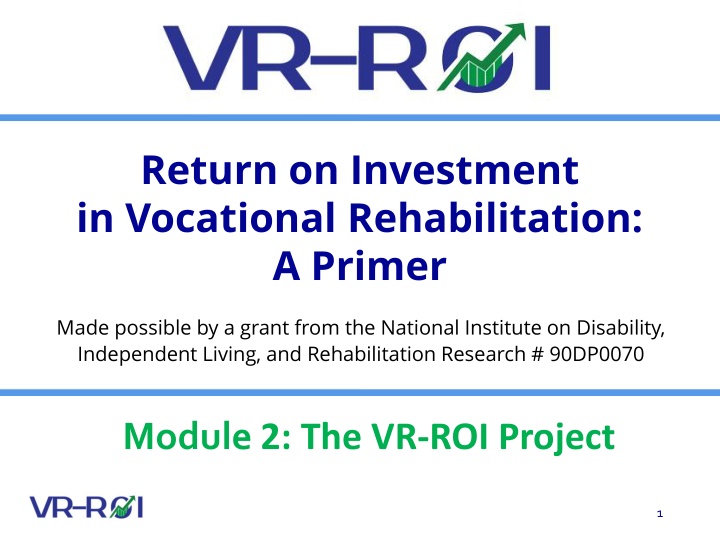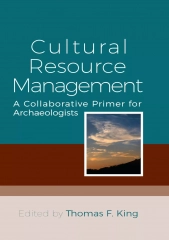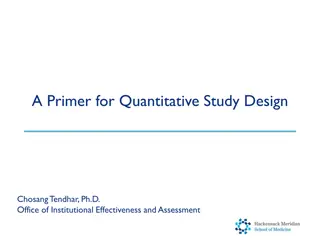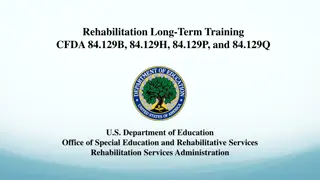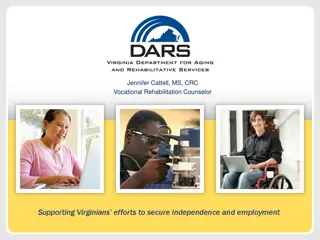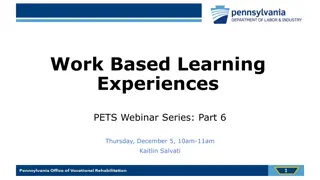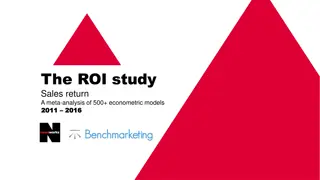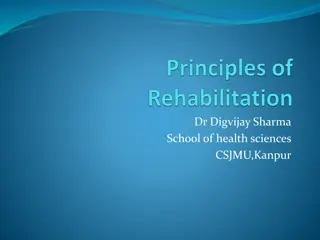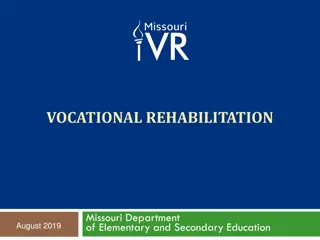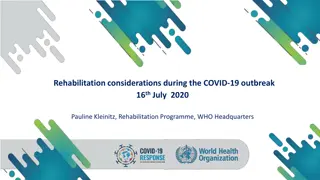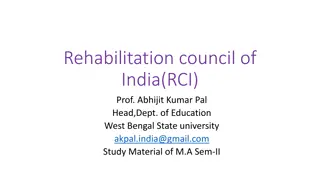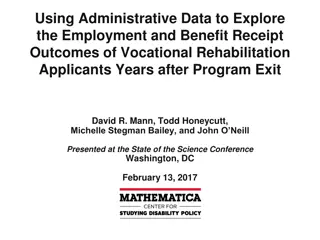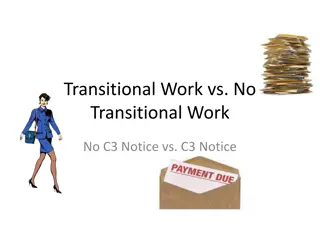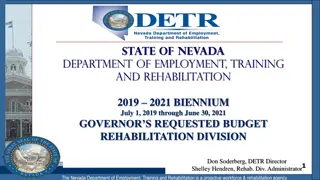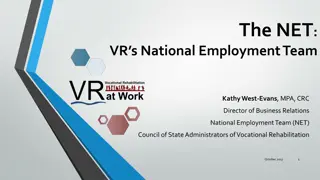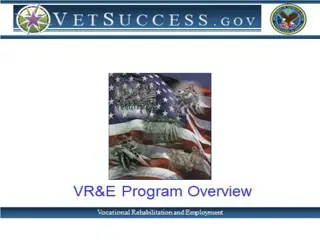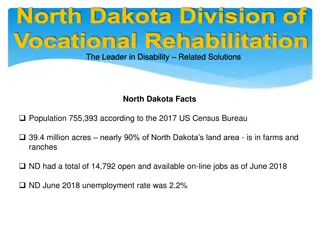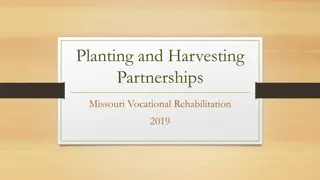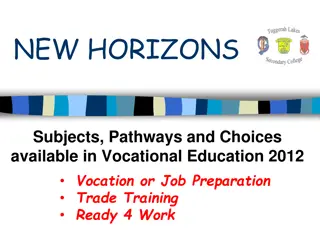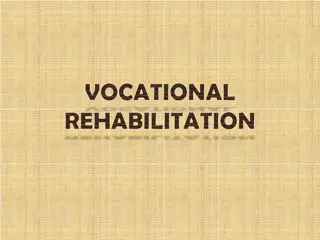Vocational Rehabilitation ROI Primer
This primer delves into the Return on Investment (ROI) in Vocational Rehabilitation, exploring concepts, terminology, and the VR-ROI Project. Learn about estimating ROI for VR services and enhancing your knowledge through modules designed for continuing education credits.
Download Presentation

Please find below an Image/Link to download the presentation.
The content on the website is provided AS IS for your information and personal use only. It may not be sold, licensed, or shared on other websites without obtaining consent from the author.If you encounter any issues during the download, it is possible that the publisher has removed the file from their server.
You are allowed to download the files provided on this website for personal or commercial use, subject to the condition that they are used lawfully. All files are the property of their respective owners.
The content on the website is provided AS IS for your information and personal use only. It may not be sold, licensed, or shared on other websites without obtaining consent from the author.
E N D
Presentation Transcript
Return on Investment in Vocational Rehabilitation: A Primer Made possible by a grant from the National Institute on Disability, Independent Living, and Rehabilitation Research # 90DP0070 Module 2: The VR-ROI Project 1
Beginning Instructions The VR ROI 101 Modules are intended to provide useful information regarding Return on Investment concepts. The intent is to use all 3 modules (1 Basic Terminology, 2 The VR-ROI Project, and 3 - VR ROI applied examples) to enhance your understanding of ROI and your confidence in accurately applying ROI concepts in your work setting. Be sure that you view Module 1 and have an understanding of basic ROI terminology before continuing! 3
Continuing Education Credit You may use the VR ROI 101 Modules to expand your knowledge of this topic and to earn continuing education credits. When you complete each ROI 101 Module, you can complete the evaluation and earn 1 CRC (Certified Rehabilitation Counselor) credit. Once you complete the evaluation, your certificate will be emailed to you. These credits are pre-approved by the Commission on Rehabilitation Counselor Certification. You can also submit your CRC Credit Certificate for post-approved credit with other licensure or certifying bodies. 4
Quick Review of Module 1 In Module 1, you learned about some: ethical considerations regarding the use of ROI; definitions of key Return on Investment terms (Investment, Return, ROI to Whom?, TVOM or Time Value of Money, Net Present Value, Benefit to Cost Ratio, Internal Rate of Return); and advantages and disadvantages of the forms for reporting ROI. This information should be of assistance as you learn more in this module about the VR ROI model and project. In Module 2, you will be introduced to the VR-ROI Project which utilizes ROI modeling within the context of vocational rehabilitation programs. 6
Multiple Different Approaches Different approaches have been used to estimate the ROI for VR services. These approaches use different types of data and statistical models, and vary in complexity and rigor. Description of several approaches can be found in the 38th Institute on Rehabilitation Issues publication, available at http://www.iriforum.org/download/38IRI_ROI.pdf The VR ROI project uses an approach to estimating ROI that differs from previous efforts. 7
The VR-ROI Project Funded by NIDILRR (National Institute on Disability, Independent Living, and Rehabilitation Research, formerly NIDRR) 9
The VR- ROI Project : Some History First grant started in 2010, partnering with 4 state VR agencies: Maryland Combined, Oklahoma Combined, Virginia General and Blind Objective: Test the applicability of valid, methodologically rigorous processes for assessing ROI at a state agency level Current grant started in 2014, expanding to include Delaware General, Kentucky General, North Carolina General and Blind, and Texas Combined. Objectives: Refine and test the ROI model with a more heterogeneous set of state agencies Develop and test the applicability of a user-friendly Web-based ROI Estimator 10
VR ROI Projects Approach (1 of 2) This is not your father s VR-ROI The approach is much richer than a simple formula to calculate ROI for a generic VR customer who receives a generic VR service package. From the agency s perspective, the project can be used as: A supplement to WIOA s Common Measures A tool to learn about your specific program A means to satisfy legislators information needs with rigorous ROI data 11
VR ROI Projects Approach (2 of 2) Although the cost side presents its own issues, estimating benefits of VR services receipt is by far the most challenging aspect of estimating VR-ROI. Attempts to answer the question, how would this VR customer have fared in the labor market had she or he not received VR services. Because this counterfactual cannot be answered directly and randomized clinical trials are costly and present their own issues, it is addressed statistically. The following slides describes and seven key features of the VR-ROI approach to ROI. Module 3 illustrates the value of these features by showing selected results for Virginia General. Some of WIOA s basic tenets are embedded in the VR-ROI model. These are mentioned where appropriate. 12
VR ROI Feature # 1: Readily-Available Administrative Data Uses readily-available administrative data from: State VR agencies (participant characteristics, services) State Unemployment Insurance wage system (employment and earnings) FEDES (Federal Employment Data Exchange System) and SWIS (State Wage Interchange System) with approvals WIOA discussion of cross-agency administrative data Encourages use of common state identifier for individuals in core programs Would enable states to share data and track services across programs at the individual level Emphasis on documenting competitive employment and earnings unemployment insurance wage records, tax records, earnings statements from the employer, and self-reported information 13
VR ROI Feature # 2: Estimate VR s Impact from Service Start Estimate VR s impact from when services begin, not when they end (i.e., applicant cohorts rather than closure cohorts) Applicants in a given fiscal year face similar VR rules (including possible order-of-selection) as well as employment climates Helps control for extraneous factors that can influence a VR customer s participation and employment. Moves focus toward service provision and away from closure status (e.g., exited with or without employment outcome). WIOA and RSA RSA-911 report focuses on closures during a period However, RSA is planning to review open cases quarterly for WIOA s Measurable Skills Gains 14
VR ROI Feature # 3: Estimate Longitudinal VR Impacts Up to 3 years of pre-VR employment & earnings and at least 5 years of post-application data Pre-application data provides a baseline before service provision Multiple years of post-application data to allow for An increasing emphasis in VR on serving transitioning youth Estimating the longer-term impact of training and education as well as the quicker impact of placement-oriented services WIOA has revised the metric for assessing a successful VR outcome Competitive Integrated Employment 2nd and 4th quarters following closure This is a change from employment and earnings at the time of closure 15
VR ROI Feature # 4: Examine Different Disabling Conditions Separately examine the impact of VR for individuals with different kinds of disabling conditions Examples: mental illness, intellectual disability, learning disabilities, physical impairments, blindness and vision impairments Sample size permitting: autism spectrum disorder, traumatic brain injury WIOA and RSA RSA-911 has long collected information about disabling conditions Increasing emphasis on students and youths with disability 16
VR ROI Feature # 5 (slide 1 of 2): Examine Impact of Specific Service Types Rather than a generic VR service, estimate the impacts of specific types of VR services. DTERMPS: Diagnostic, Training, Education, Restoration, Maintenance, Placement, Job Support For blindness services: also Assistive Technology, Orientation & Mobility WIOA and RSA both acknowledge the richness of services provided by VR WIOA: ensure that all individuals with disabilities served through the VR program are provided every opportunity to achieve competitive integrated employment RSA: As of FFY 2014, RSA-911 closure file collects substantially more detail on more service categories (28 vs. 22) 17
VR ROI Feature # 5 (slide 2 of 2): Examine Impact of Specific Service Types Service Categories & Mapping: DTERMPS Diagnosis & evaluation: services for assessing eligibility and developing IPE, medical diagnostics Training: OJT, GED, vocational, etc. Education: post-secondary education Restorative: medical/healthcare services (see also AO below) Maintenance: transportation, clothing, vehicle/home modifications, etc. Placement: search, placement, job readiness training, etc. Job Supports: on-job supports, supported employment AO: Entered separately for blindness services; included within Restorative for all other disabilities Assistive Technology: AT, rehabilitation engineering Orientation & Mobility: adjustment to disability 18
VR ROI Feature # 6: Rigorous Statistical Model Ideally, we would observe the same person with and without VR services over the same time period, but this is not possible. To get closer to that ideal, estimate service impacts on employment and earnings: Control for observed explanatory variables (e.g., gender, education, race, disability, local labor market conditions) Employ state-of-the-science statistical controls to ensure that the outcomes are the result of VR rather than other factors A technical discussion of the statistical issues (including selection bias ), methodology, and results is provided in Dean, et al. (2015 and 2018) see Reference slides at end. 19
VR ROI Feature # 7: Estimates Made at Individual Level The model estimates employment & earnings impacts as well as service costs at the individual level Provides the flexibility to obtain ROI estimates for different client groups by aggregating them for a disability or even the entire agency Approach aligns with WIOA s intent to examine impact of VR services on earnings and outcomes 20
Conclusion of Module 2 You have now completed Module 2 and should have a general understanding of the VR-ROI Project and some ethical implications associated with the application of this knowledge. Please be sure to continue learning about VR-ROI through practical application and examples highlighted in Module 3. 21
References (1 of 2) Additional information about PERT and its evaluation. Ashley, J., Dean, D., Rowe, K., & Schmidt, R. (2006). The Long-Term Impact of Comprehensive Vocational Assessment for Youth with Disabilities in Transition: Evaluation of Virginia s Post-Secondary Education/ Rehabilitation Transition (PERT) Program. Vocational Evaluation and Career Assessments Professionals Journal, 2(2), 14-32. Ashley, J. & Schmidt, R. (2016). Investing in Career Opportunities for Youths with Disabilities. Presentation to the Torch Club of Richmond, VA. PowerPoint found at vroi.org/resources 22
References (2 of 2) Publications in academic journals discussing statistical issues, methodology, and results of the VR-ROI model. Dean, D., Pepper, J., Schmidt, R., Stern, S. (2015). The Effects of Vocational Rehabilitation for People with Cognitive Impairments. International Economic Review, 56 (No. 2, May 2015), 399-426. Dean, D., Pepper, J., Schmidt, R., Stern, S. (2017). The Effects of Vocational Rehabilitation for People with Mental Illness. Journal of Human Resources, 52 (No. 3, Summer 2017), 826-858. Dean, D., Pepper, J., Schmidt, R., Stern, S. (2018). The Effects of Vocational Rehabilitation for People with Physical Disabilities. Journal of Human Capital, 12 (No. 1, Summer 2018), 1-37. 23
